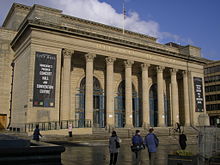| Revision as of 16:08, 21 August 2006 editWarofdreams (talk | contribs)Autopatrolled, Administrators127,600 edits Category:1934 architecture← Previous edit | Revision as of 16:41, 21 August 2006 edit undoVinceBowdren (talk | contribs)Extended confirmed users2,337 editsm spellingNext edit → | ||
| Line 7: | Line 7: | ||
| The ] was designed in ] by ], but was not completed until ]. It is a ] building with a giant ]. The largest ] in the building, seating 2,800 people, is commanded by a grand ]. | The ] was designed in ] by ], but was not completed until ]. It is a ] building with a giant ]. The largest ] in the building, seating 2,800 people, is commanded by a grand ]. | ||
| The City Hall and its |
The City Hall and its surroundings have recently (2005) been refurbished and re-developed. | ||
| ==References== | ==References== | ||
Revision as of 16:41, 21 August 2006

Sheffield City Hall is a Grade II* listed building containing several venues, ranging from auditoria to a ballroom, in Sheffield, England.
The large hall dominates Barker's Pool, one of the most-used squares in Sheffield, containing the city's War Memorial.
The City Hall was designed in 1920 by E. Vincent Harris, but was not completed until 1934. It is a neo-classical building with a giant portico. The largest hall in the building, seating 2,800 people, is commanded by a grand dome.
The City Hall and its surroundings have recently (2005) been refurbished and re-developed.
References
- English Heritage (1973) City Hall. Images of England (accessed 20 February 2006).